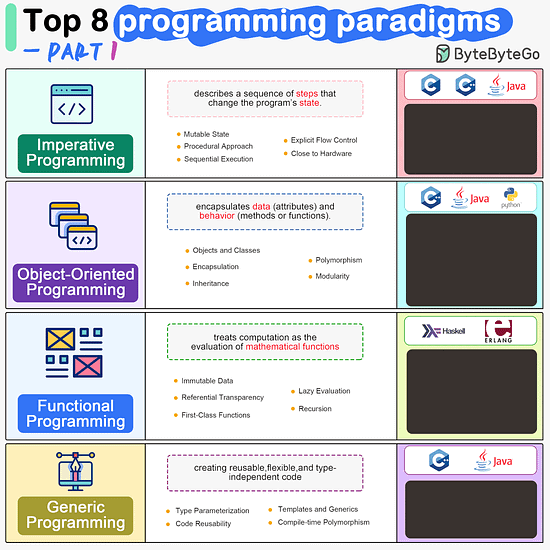#modular javascript
Explore tagged Tumblr posts
Text
A Programming Hook
Object-Oriented Programming's strength is Modularity; and just about everything coded today follows the OOP design. Except Python and JavaScript--sometimes.
So I've coined a term "Hook"; not to be confused with a fishing-line-hook, or the literary tool where you write the most interesting part of your whole story into the first sentence.
A [Hook] in this regard is a [Space for Something]{to go} like a nook or a closet. You don't know *what* might go into that nook or closet; you just know there are *things* with which are properly displayed or stored in a Nook or in a Closet.
And this is the same concept.
There's a *whole* lot of features that we'd might *wish* to add to a coding project, yet time and funding constraints, oftentimes, makes it hard to include every feature one might want.
In this vein; we add space for the features we might want to add *after* we finish all the important bits.
This is very important in [Software Engineering], because there will be a time in a project where you make it to an important feature that you cannot implement *without* having had re-written the *whole* thing.
And so, you want options available when that inevitably comes to pass.
Now. I developed this whole making [Training Simulations] in the [Air Force] and when I tell you; one day somebody asked me to do something that may have added several weeks to the development time.
They asked "How long will this take to [fix]?" To which I responded; "I'm not sure. I think I remember adding some hooks that would make this easy, and it could be done tonight. But as it wasn't a requirement *at the time* this may take 2-4 weeks to implement if I have to rework it from scratch."
To which, they were very upset with my best time "4 hours, or the end of shift, whichever comes first" or "several weeks, because that would put us behind schedule."
"I'll get back to you at the end of day Chief!"
Non-developers, Maintenance Professionals like myself *actually* who're used to every little thing being documented and not *created on the fly* were rather upset with those timelines.
And I had already been reprimanded several times based on my timeline predictions.
Which uh. Were accurate. They just weren't particularly accurate *for me* whom'st {is/was} a very well educated developer... In a sea of maintainers who have not studied the code as I have done.
My timelines were usually off at this stage *because* I was getting my understanding of how the coders (who were also rather green) and the (maintainers become coders) would be able to understand the timelines.
I have to make clear; I was, in-fact, doing *my* job to the best of my ability, and even better than *your{my supervisor's}* ability despite them being very concerned about my time estimates being [too long].
Communication isn't bad on my side... Even when I appear to be bad at communicating.
One of these days I will not be so defensive! Yet the Anti-Trans sentiment remains, so will the SALT!
Anyway; these particular [Hooks] were contextual triggers. Things that would/should be called at certain times during certain steps in the simulation.
Custom CallBack functions mostly.
And these particular callbacks were rather complex for a simple one-function call event.
Luckily for my OCD brain; I had stopped to asked the question about this exact feature they wanted to add *now* that they had been worried about adding earlier, until the customer made it a [Need to have].
I had asked the question, at that time; "What happens if *this* particular feature *becomes* a Necessary addition."
Because my [awesome predictive abilities] were spot on about what they need that particular simulation to accomplish.
Luckily I had been stumbling through various frameworks and implementations of the Squadrons Honorable Historical Developments. (Part of the job was updating and modernizing old Adobe Flash 2.0 projects) And had stumbled across a few implementations of these features *both* before it was necessary *and* after it seems to have taken a week to tack on at the end.
And that's when I started adding the concept of "Hooks" to my personal development checklist. Everytime you ask yourself; "How might this feature be used outside this implementation" or "What happens if I need to add something *somewhere* that might break Modularity" is an opportunity to add in hooks.
"Can I go back, and reuse this feature to make my job easier in the future?"
Or you know; Object-Oriented Design (And Modularity) in a nutshell.
19 notes
·
View notes
Text
i've always been kinda interested in making my own music for w/e game thing i make, & between listening to some king gizzard & the lizard wizard music b/c of that come see him video that everybody reblogs all the time and rewatching an old youtube video about the tuning of gamelan music AND finding an old talk about functional music construction AND discovering that there's now a builtin javascript synthesizer library (the 'web audio api') i was like, hey, i could actually try out synthing up some music.
like, i'm not gonna try putting anything real together yet but i could at least read up on the api since it seems incredibly complicated. it really is a conceptual modular synthesizer where components are linked together with signals. wires everywhere
anyway i was like, let's look at how to make a sine wave. "sine" is a preset but beyond that it gets into arbitrary waveforms
Here, we create a PeriodicWave with two values. The first value is the DC offset, which is the value at which the oscillator starts. A value of 0 is good here because it starts the curve at the middle of the [-1.0; 1.0] range. The second and subsequent values are sine and cosine components, similar to the result of a Fourier transform, which converts time domain values to frequency domain values. Here, with createPeriodicWave(), you specify the frequencies, and the browser performs an inverse Fourier transform to get a time domain buffer for the frequency of the oscillator. In this example, we set only one component at full volume (1.0) on the fundamental tone, so we get a sine wave. Bear in mind that the fundamental tone corresponds to the oscillator's frequency (which, by default, is 440 Hz). Therefore, altering the oscillator's frequency effectively shifts the frequency of this periodic wave along with it.
The coefficients of the Fourier transform should be given in ascending order (i.e. (a+bi)ei,(c+di)e2i,(f+gi)e3i etc.) and can be positive or negative. A simple way of manually obtaining such coefficients (though not the best) is to use a graphing calculator.
music from first principles, everybody!!
8 notes
·
View notes
Text
The hacker ecosystem in Russia, more than perhaps anywhere else in the world, has long blurred the lines between cybercrime, state-sponsored cyberwarfare, and espionage. Now an indictment of a group of Russian nationals and the takedown of their sprawling botnet offers the clearest example in years of how a single malware operation allegedly enabled hacking operations as varied as ransomware, wartime cyberattacks in Ukraine, and spying against foreign governments.
The US Department of Justice today announced criminal charges today against 16 individuals law enforcement authorities have linked to a malware operation known as DanaBot, which according to a complaint infected at least 300,000 machines around the world. The DOJ’s announcement of the charges describes the group as “Russia-based,” and names two of the suspects, Aleksandr Stepanov and Artem Aleksandrovich Kalinkin, as living in Novosibirsk, Russia. Five other suspects are named in the indictment, while another nine are identified only by their pseudonyms. In addition to those charges, the Justice Department says the Defense Criminal Investigative Service (DCIS)—a criminal investigation arm of the Department of Defense—carried out seizures of DanaBot infrastructure around the world, including in the US.
Aside from alleging how DanaBot was used in for-profit criminal hacking, the indictment also makes a rarer claim—it describes how a second variant of the malware it says was used in espionage against military, government, and NGO targets. “Pervasive malware like DanaBot harms hundreds of thousands of victims around the world, including sensitive military, diplomatic, and government entities, and causes many millions of dollars in losses,” US attorney Bill Essayli wrote in a statement.
Since 2018, DanaBot—described in the criminal complaint as “incredibly invasive malware”—has infected millions of computers around the world, initially as a banking trojan designed to steal directly from those PCs' owners with modular features designed for credit card and cryptocurrency theft. Because its creators allegedly sold it in an “affiliate” model that made it available to other hacker groups for $3,000 to $4,000 a month, however, it was soon used as a tool to install different forms of malware in a broad array of operations, including ransomware. Its targets, too, quickly spread from initial victims in Ukraine, Poland, Italy, Germany, Austria, and Australia to US and Canadian financial institutions, according to an analysis of the operation by cybersecurity firm Crowdstrike.
At one point in 2021, according to Crowdstrike, Danabot was used in a software supply-chain attack that hid the malware in a javascript coding tool called NPM with millions of weekly downloads. Crowdstrike found victims of that compromised tool across the financial service, transportation, technology, and media industries.
That scale and the wide variety of its criminal uses made DanaBot “a juggernaut of the e-crime landscape,” according to Selena Larson, a staff threat researcher at cybersecurity firm Proofpoint.
More uniquely, though, DanaBot has also been used at times for hacking campaigns that appear to be state-sponsored or linked to Russian government agency interests. In 2019 and 2020, it was used to target a handful of Western government officials in apparent espionage operations, according to the DOJ's indictment. According to Proofpoint, the malware in those instances was delivered in phishing messages that impersonated the Organization for Security and Cooperation in Europe and a Kazakhstan government entity.
Then, in the early weeks of Russia's full-scale invasion of Ukraine, which began in February 2022, DanaBot was used to install a distributed denial-of-service (DDoS) tool onto infected machines and launch attacks against the webmail server of the Ukrainian Ministry of Defense and National Security and Defense Council of Ukraine.
All of that makes DanaBot a particularly clear example of how cybercriminal malware has allegedly been adopted by Russian state hackers, Proofpoint's Larson says. “There have been a lot of suggestions historically of cybercriminal operators palling around with Russian government entities, but there hasn't been a lot of public reporting on these increasingly blurred lines,” says Larson. The case of DanaBot, she says, “is pretty notable, because it's public evidence of this overlap where we see e-crime tooling used for espionage purposes.”
In the criminal complaint, DCIS investigator Elliott Peterson—a former FBI agent known for his work on the investigation into the creators of the Mirai botnet—alleges that some members of the DanaBot operation were identified after they infected their own computers with the malware. Those infections may have been for the purposes of testing the trojan, or may have been accidental, according to Peterson. Either way, they resulted in identifying information about the alleged hackers ending up on DanaBot infrastructure that DCIS later seized. “The inadvertent infections often resulted in sensitive and compromising data being stolen from the actor's computer by the malware and stored on DanaBot servers, including data that helped identify members of the DanaBot organization,” Peterson writes.
The operators of DanaBot remain at large, but the takedown of a large-scale tool in so many forms of Russian-origin hacking—both state-sponsored and criminal—represents a significant milestone, says Adam Meyers, who leads threat intelligence research at Crowdstrike.
“Every time you disrupt a multiyear operation, you're impacting their ability to monetize it. It also creates a bit of a vacuum, and somebody else is going to step up and take that place,” Meyers says. “But the more we can disrupt them, the more we keep them on their back heels. We should rinse and repeat and go find the next target.”
4 notes
·
View notes
Text
One of the neat consequences of the design of the language I'm working on with operatives instead of macros and a modular categorical semantics, is that everything that would be a keyword or special operator in other languages can be an operative in ours, which means they can be replaced and changed and modified in user code. This means that in this language the problem of two different dependencies of the same project wanting to use different versions of the language reduces to the problem of different dependencies wanting to use different libraries, and no system of complicated features pragmas or standard command line arguments that grow and grow and grow over time is necessary. Instead we can just have different versions of the syntax as ordinary libraries, versioned, polyfilled, dependency injected. Similarly, the formally meaningful modular semantics system means that we can add and remove features without that being a global decision; an old library that uses an old semantics can be transported to a new semantics by a functor, and we can prove that the functor implements all the axioms of the original semantics in terms of the new semantics, and then the old library will work just like a native library on the new semantics, with all its types, code, proofs and properties available for use and to the optimizer. A library written next year and proven correct should still run correctly in 300 years with no maintenance specific to that library. The compiler will of course need maintenance to keep it running on new hardware generations and adopt new technology.
But this isn't just a speculative future thing. Right now, modular semantics are useful in writing a project that works on multiple targets. For example, it might be useful to write a library that does some math which can work when compiled to JavaScript, wasm, or native. These targets have huge differences between them, but with modular semantics it's possible to just write using the minimal set of primitives needed, working from abstract high level collection data structures and math operations, and then any project that works in a specific system can just request a version of your package transported to their system, and all the high level data structures and properties will be filled in with whatever their platform uses to interop at full native speed. This also works in reverse; code that runs in a webpage using webgpu can have different primitives available based on which device they will run on, and not only share common libraries and types between them but also use target specific features like garbage collection or warp level parallel operators, even if the code is mixed in a single file to collect both facets of the implementation of a specific feature, and the compiler will give a nice type error if one of them gets used in the wrong place.
6 notes
·
View notes
Text
WEBCOMIC TEMPLATES
Every couple of months or so I scour the internet looking for new and innovative webcomic templates to use, since ComicPress has abandoned us and Webcomic is not very useful. Here are a few that I came across recently ... not that they are necessarily new, but I was not aware of their existence.
Rarebit is an HTML Webcomic Template written in simple and extensively commented code that even an HTML/JS beginner can figure it out, but modular enough that an HTML/JS pro can make it special. Everything is done in HTML and vanilla JavaScript, you don't need Bootstrap or JQuery or anything. Just download the template and plug your comics in.

The second one is ...

For those of you familiar with Square Space here is a template by Clay Yount.

This is probably the slickest most professional looking template I have seen but Clay stopped using it because of a a bug that fundamentally broke his comic archive template and no recieved no support from Square Space so he moved on.
#makecomics#webcomics#webcomic#clipstudio#webtoon#webcomicstemplate#toocheke#rarebit#comicfury#comicpress
3 notes
·
View notes
Text

ByteByteGo | Newsletter/Blog
From the newsletter:
Imperative Programming Imperative programming describes a sequence of steps that change the program’s state. Languages like C, C++, Java, Python (to an extent), and many others support imperative programming styles.
Declarative Programming Declarative programming emphasizes expressing logic and functionalities without describing the control flow explicitly. Functional programming is a popular form of declarative programming.
Object-Oriented Programming (OOP) Object-oriented programming (OOP) revolves around the concept of objects, which encapsulate data (attributes) and behavior (methods or functions). Common object-oriented programming languages include Java, C++, Python, Ruby, and C#.
Aspect-Oriented Programming (AOP) Aspect-oriented programming (AOP) aims to modularize concerns that cut across multiple parts of a software system. AspectJ is one of the most well-known AOP frameworks that extends Java with AOP capabilities.
Functional Programming Functional Programming (FP) treats computation as the evaluation of mathematical functions and emphasizes the use of immutable data and declarative expressions. Languages like Haskell, Lisp, Erlang, and some features in languages like JavaScript, Python, and Scala support functional programming paradigms.
Reactive Programming Reactive Programming deals with asynchronous data streams and the propagation of changes. Event-driven applications, and streaming data processing applications benefit from reactive programming.
Generic Programming Generic Programming aims at creating reusable, flexible, and type-independent code by allowing algorithms and data structures to be written without specifying the types they will operate on. Generic programming is extensively used in libraries and frameworks to create data structures like lists, stacks, queues, and algorithms like sorting, searching.
Concurrent Programming Concurrent Programming deals with the execution of multiple tasks or processes simultaneously, improving performance and resource utilization. Concurrent programming is utilized in various applications, including multi-threaded servers, parallel processing, concurrent web servers, and high-performance computing.
#bytebytego#resource#programming#concurrent#generic#reactive#funtional#aspect#oriented#aop#fp#object#oop#declarative#imperative
8 notes
·
View notes
Text
Andy's 2024 Year in Review
I tend to work on a lot of small projects with a smattering of larger ones mixed in. Often I end the year thinking I didn't do all that much, but then I start going through my posts and realize that I did more than I thought! Hard to believe that stuff I did last January was this year!
I've fallen out of the habit of doing these year-in-review posts, which is a shame, but I'm turning that around right now! Here's a quick look at all the things I made last year.
EMMA

Probably the biggest thing for me is another successful year of the coop I'm a part of, EMMA Technology Cooperative. After a somewhat tough 2023, we bounced back this year. Seeing us survive a lean time and watching the coffers refill in the past year really drove home the value of organizing around cooperation as opposed to infinite growth. And if you're reading this and in need of a creative technologist, please drop us a line!
Taper - January

A the start of this year I was on the editorial board of Taper, online literary journal for computational poetry. I only assisted with one issue (which I also contributed to!) but it was a very new experience for me and I'm happy I could be a part of it!
A few years ago I kind of stumbled into the occasional piece of digital poetry without ever realizing. I was doing a literal poetry reading when I realized that I write poems from time to time. It's very fun that my practice occasionally pulls me in unexpected directions.
MAGFest - January

Every year, we bring all of the games in the Arcade Commons collection to the Music and Games Festival just outside of Washington DC. It is our biggest show of the year by a mile and I love it every time. There is a DIY spirit to MAGFest that really sets it apart from any other con I've been to. We're well underway for 2025 as I write this. As I frequently do, I emceed a bunch of our tournaments.
The Algorithm - February

What a fun project this was! Alia ElKattan and Lujain Ibrahim contacted me about their Mozilla Foundation-funded project to explain how algorithmic feeds work. I created modular P5JS animations to serve as the "content" for their app.
They found me via the P5 tweetcarts I had been posting during the pandemic. I got to explore some of those same ideas without the super tight character restrictions.
Check it out here.
EMMA Skillshare - March

I did a small workshop on getting PICO-8 to communicate with Javascript. This was the basis for my project Pico Pond which I wrote about on the EMMA Blog.
This skillshare took those ideas and presented them in a livestream, which you can watch here.
Our Generation - May

I was contacted by Nick Montfort to submit a piece of computer generated poetry for a small-run book called Our Generation: Programs + Computer-Generated Texts. I channeled my inner Jenny Holzer for this and really enjoyed it. The full src appears at the top of the page and it was interesting to factor that in to make sure the output exactly filled the page. I keep thinking it would be fun to do a series using this size restriction but I haven't done it yet.
You can see my full page here.
Tastebud Tapdancer - May

You've been swallowed by a giant serpent but you're trying to make the best of it.
A little video game with a source code of just 500 characters! Made for TweetTweetJam 9 You can play it here.
The Indomitable Rocket Dog - June

Around this point in the year is where I started working on my current project, The Indomitable Rocket Dog. I'm enjoying this game so much. I haven't made a real twitchy arcade game since PARTICLE MACE, which just celebrated its 10th birthday. It is still very early but I feel really good about this one!
After MAGFest 2024 I was percolating on physics-y arcade games mostly because I am so deeply in love with Hoverburger by Nick Santaniello. Before I knew it my love of N++ was mixed in there as well.
I'm writing all of my own physics in C++ because I had a vague sense of how I want it to feel and it's a hobby project so I can do what I want.
I've been documenting my development on it in a mastodon thread.
Isabelle Poppy And Bling - August

OK, this one isn't new at all! This is a flash game I made in 2009 for musician Justin Braun. But this year I got it playable on the web again!
Like so many game developers my age, I got my start with Macromedia Flash. This game felt like the culmination of my style at the time, which was heavily influenced by Animutation. I was starting to be more deliberate with my collage style as opposed to aiming for totally random elements. I think I got paid $600 for it, which felt huge at the time.
1K Pac-Man - September

Another size coded game. This time it's as faithful a recreation of Pac-Man as I could muster in 1024 bytes of source code. All of the ghost logic is accurate to the original!
You can play it here. I'm very pleased with the mouth animation.
I made it for PICK-1K Jam 2024. I do wish I had read the page a little more carefully though. The jam required compressed source to be 1024 bytes and I did raw source. The game is only 723 compressed bytes so I had a lot of room to expand, but by the time I realized that I had painstakingly trimmed and optimized my code and I couldn't imagine untangling it. Oops.
Cloud Gobblers - November

Arcade Commons received a grant from the Brooklyn Arts Council to create an arcade machine showing a collection of games that incorporate weather data into the gameplay. EMMA was commissioned to make one of the games. Cloud Gobblers is a snake-style game where the playfield is a video satellite field of global cloud coverage over a period of 48 hours.
This was the first time all of the members of EMMA worked together on one project!
Three Tapestries - October

I didn't make many pen plotter drawings this year, but I really liked this one. You can see the full thing here.
It's currently still available in my shop! Until somebody buys it it will be hanging on the wall in my office.
Lever Up Jam - December

Back in 2021, I worked with Matt Lepage on an alt-control game jam called Jam Jam Revolution. We prepped a parts list so all participants could build the same controller and make games for it. This year we decided to dust off that idea with the Lever Up Jam. This time there will be a full-sized cabinet at MAGFest that the games can be played on!
My favorite TweetCarts / Postcarts This Year
I no longer use Twitter, but I have been making the occasional tweetcart (a PICO-8 sketch with source code 280 bytes or less) and posting them on tumblr and mastodon. But there was an exciting development towards the end of the year! Lexaloffle, the creator of Pico-8 created a section on the BBS for 300 char or less "Postcarts", so we now have a centralized home for these little byte-sized demos.
Here are three of my favorite postcarts that I made this year:
Spinning Cube v3 - April

p=pset::_::cls()for i=0,99do u=0s=i/4+t()/5x=64+sin(s)*39a=64+sin(s+.25)*39y=39+cos(s)*9b=39+cos(s+.25)*9line(x,y,a,b,6)for k=0,99do if x>a and i<4and k<50then line(x,y+k,a,b+k,k>48and 7or 9+i)p(x,y+k,7)p(a,b+k)end v=pget(i,k)u+=v if(v>6)break if(u>0)p(i,k,8)end end flip()goto _
Big year for making things spin. You can check out my tumblr post to see all my attempts at perfecting this spinning cube. The outlines were the real cherry on top for me.
Balatro Spinning Card - May

a=abs::_::cls()e=t()for r=0,46do for p=0,1,.025do j=sin(e)*20k=cos(e)*5f=1-p h=a(17-p*34)v=a(23-r)c=1+min(23-v,17-h)%5/3\1*6u=(r-1)/80z=a(p-.2)if(e%1<.5)c=a(r-5)<5and z<u+.03and(r==5or z>u)and 8or 8-sgn(h+v-9)/2 g=r+39pset((64+j)*p+(64-j)*f,(g+k)*p+(g-k)*f,c)end end flip()goto _
This was so hard to make! I can't believe I did it. I wrote a giant writeup breaking down the 279 byte source code on the EMMA blog.
Fuji - October

pal({7,12,140,13,129,1,5,8,8,14,142,143,7},1)r=rnd::_::x=r(128)y=r(128)c=9+y/26-2+r(1.5) if(y<((x+40)/6)^1.6and y<((178-x)/6)^1.6and y<79+r(2))c=2.5-sgn(y-45-sin(x/21)*r(4))*1.5+r(2.5-sgn(x-69-r(8)-y/3+25)*.7) pset(x,128-y,c)a=r(1)d=r(25)pset(28+sin(a)*d,30+cos(a)*d,9)goto _
I made this during some downtime on a vacation to Japan. I was hoping to see Fuji the next day and the clouds wound up being kind to us, giving an amazing view.
I almost never make representational art and I was really happy with how this turned out.
That's it! I hope you all have a great 2025!
2 notes
·
View notes
Text
Javascript Frameworks
Absolutely, JavaScript frameworks are the backbone of modern web development, empowering developers to create robust, interactive, and responsive web applications. From Angular and React to Vue.js and beyond, these frameworks have revolutionized how we build web applications. Let's delve deeper into the world of JavaScript frameworks and explore their significance, popular choices, and their impact on web development.
Evolution of JavaScript Frameworks
JavaScript frameworks emerged to streamline the development process, offering predefined structures, libraries, and functionalities. They simplify complex tasks, making it easier to create feature-rich web applications.
Angular:
Angular, developed by Google, introduced the concept of a structured front-end framework. Its two major versions, AngularJS (1.x) and Angular (2+), introduced improvements in performance, modularity, and enhanced features like two-way data binding.
React:
React, maintained by Facebook, revolutionized front-end development with its component-based architecture. Its virtual DOM implementation significantly improved rendering efficiency, making it a go-to choice for building dynamic user interfaces.
Vue.js:
Vue.js gained popularity for its simplicity and flexibility. Its progressive framework allows developers to integrate it into existing projects seamlessly. Vue's gentle learning curve and adaptability have attracted a large community of developers.
Why Use JavaScript Frameworks?
Productivity: Frameworks provide reusable components, tools, and patterns, speeding up development.
Performance: Optimized rendering, virtual DOM, and efficient data binding contribute to faster applications.
Community Support: Active communities offer resources, libraries, and solutions to common problems.
Scalability: Frameworks often come with built-in features for scaling applications as they grow.
Choosing the Right Framework
Selecting a framework depends on project requirements, team expertise, scalability needs, and community support.
Angular: Ideal for large-scale applications requiring a complete framework solution with a structured architecture.
React: Suited for building dynamic, high-traffic applications, leveraging its virtual DOM and component-based structure.
Vue.js: A versatile choice, especially for smaller to medium-sized projects, due to its simplicity and easy integration.
The Future of JavaScript Frameworks
The landscape of JavaScript frameworks continues to evolve with updates, new releases, and the emergence of alternative frameworks. There's a trend toward optimizing performance, reducing bundle sizes, and improving developer experience.
Web Components and Micro-Frontends:
The rise of Web Components and micro-frontends is changing how developers architect applications. These technologies enable building modular, reusable components that can be utilized across frameworks and projects.
Framework Agnosticism:
Developers are exploring ways to combine different frameworks or use libraries like Svelte and Alpine.js to achieve optimal performance and flexibility while minimizing the constraints of a single framework.
Conclusion
JavaScript frameworks have significantly shaped the web development landscape, offering diverse options to cater to varying project needs. As technology evolves, the emphasis shifts towards performance, scalability, and adaptability, driving innovation in the realm of JavaScript frameworks.
Ultimately, the choice of a framework depends on the project's specific requirements, team expertise, and long-term goals. Understanding the strengths and trade-offs of each framework empowers developers to make informed decisions, ensuring the successful creation of modern, efficient web applications.
7 notes
·
View notes
Text
Front-End Development: Building the Interface of the Future
Front-end development is at the heart of creating user-friendly and visually appealing websites. It involves translating designs into code and ensuring that web applications are responsive and interactive. In this article, we explore the key aspects of front-end development, essential skills, and emerging trends in the field.
What is Front-End Development?
Front-end development focuses on the user interface (UI) and user experience (UX) aspects of web development. It involves creating the part of the website that users see and interact with, using a combination of HTML, CSS, and JavaScript.
Core Technologies
HTML (HyperText Markup Language): HTML is the foundation of web pages, defining the structure and content, such as headings, paragraphs, and images.
CSS (Cascading Style Sheets): CSS is used to style and layout web pages, controlling aspects like colors, fonts, and spacing to create an attractive and consistent look.
JavaScript: JavaScript adds interactivity and dynamic content to web pages, enabling features like form validation, animations, and user input handling.
Popular Frameworks and Libraries
React: A JavaScript library for building fast and dynamic user interfaces, particularly single-page applications.
Angular: A comprehensive framework for building large-scale applications with a structured and modular approach.
Vue.js: A flexible framework that is easy to integrate into projects and focuses on the view layer of applications.
The Role of a Front-End Developer
Turning Designs into Code
Front-end developers take designs created by UI/UX designers and turn them into code. This involves creating HTML for structure, CSS for styling, and JavaScript for functionality, ensuring the design is faithfully implemented and functional across various devices and browsers.
Ensuring Responsiveness
With the growing use of mobile devices, it’s crucial that websites work well on screens of all sizes. Front-end developers ensure that web applications are responsive, meaning they adapt smoothly to different screen resolutions and orientations.
Optimizing Performance
Performance optimization is key in front-end development. Developers reduce file sizes, minimize load times, and implement lazy loading for images and videos to enhance the user experience.
Maintaining Cross-Browser Compatibility
A successful front-end developer ensures that web applications work consistently across different browsers. This involves testing and resolving compatibility issues to provide a uniform experience.
Implementing Accessibility
Making web content accessible to people with disabilities is a critical aspect of front-end development. Developers adhere to accessibility standards and best practices to ensure that everyone can use the website effectively.
Essential Skills for Front-End Developers
Mastery of Core Technologies
Proficiency in HTML, CSS, and JavaScript is fundamental. Front-end developers must be able to write clean, efficient code that is both maintainable and scalable.
Familiarity with Modern Frameworks
Knowledge of modern frameworks like React, Angular, and Vue.js is crucial for building contemporary web applications. These tools facilitate the creation of complex, dynamic interfaces.
Version Control with Git
Version control systems like Git are essential for tracking changes in the codebase and collaborating with other developers. Mastery of Git allows for efficient project management and collaboration.
Understanding of UX/UI Design
An understanding of UX/UI principles helps developers create user-friendly and aesthetically pleasing interfaces. This includes knowledge of user behavior, usability testing, and design basics.
Problem-Solving and Debugging
Front-end development often involves troubleshooting issues related to layout, functionality, and performance. Strong problem-solving skills are essential to identify and resolve these challenges efficiently.
Emerging Trends in Front-End Development
Progressive Web Apps (PWAs)
PWAs combine the best features of web and mobile applications, offering fast loading times, offline capabilities, and push notifications. They provide a native app-like experience within the browser.
WebAssembly
WebAssembly allows developers to run high-performance code in web browsers. It enables complex applications like games and video editors to run efficiently on the web, expanding the possibilities of front-end development.
Server-Side Rendering (SSR)
Server-side rendering improves the loading speed of web pages and enhances SEO. Frameworks like Next.js (for React) facilitate SSR, making it easier to build fast and search-friendly applications.
Single Page Applications (SPAs)
SPAs load a single HTML page and dynamically update the content as users interact with the application. This approach provides a smoother user experience, similar to that of a desktop application.
Component-Based Development
Modern frameworks emphasize component-based architecture, where UI elements are built as reusable components. This modular approach enhances maintainability and scalability.
AI and Machine Learning Integration
Integrating AI and machine learning into front-end development enables the creation of smarter, more personalized applications. Features like chatbots, recommendation engines, and voice recognition can significantly enhance user engagement.
#FrontEndDevelopment#WebDevelopment#UIUXDesign#HTML#CSS#JavaScript#ReactJS#Angular#VueJS#ResponsiveDesign#WebDesign#UserExperience#WebPerformance#WebAccessibility#SinglePageApplication#ProgressiveWebApp#WebDevelopmentTrends#ModernWebDev#FrontendFrameworks#CodeNewbie#LearnToCode#WebDevCommunity#CodingLife#TechTrends#WebComponents#WebAssembly#ServerSideRendering#DigitalDesign#UIComponents#WebOptimization
3 notes
·
View notes
Text
Top 20 Backend Development Tools In 2023
Backend development plays a crucial role in the operation and performance optimisation of web and mobile applications, serving as their foundational framework. In the context of the dynamic technological environment, it is imperative for developers to remain abreast of the most recent and effective backend development technologies. In the year 2023, a plethora of advanced tools have surfaced, leading to a significant transformation in the approach to backend development. Reach out to Nivida Web Solutions - a noted Web development company in Vadodara and let's craft a website that sets you apart.
This analysis aims to examine the leading 20 backend development tools projected for the year 2023, which possess the potential to optimise operational effectiveness, raise work output, and achieve exceptional outcomes.
1. Node.js:
Node.js continues to be a prominent contender in the realm of backend development, offering a resilient framework for constructing scalable, server-side applications through the utilisation of JavaScript. The asynchronous and event-driven nature of the system renders it highly suitable for real-time applications and microservices.
2. Express.js:
Express.js is a Node.js framework that offers a basic and flexible approach to backend development. It achieves this by providing streamlined routing, efficient handling of HTTP requests, and effective management of middleware. The software possesses a high degree of extensibility, allowing developers to create tailored solutions.
3. Django:
Django, a renowned Python framework, is widely recognised for its exceptional performance, robust security measures, and remarkable scalability. The framework adheres to the "batteries-included" principle, providing a wide range of pre-installed functionalities and libraries that enhance the speed and efficiency of the development process.
4. Flask:
Flask, an additional Python framework, is characterised by its lightweight nature and user-friendly interface. The framework offers fundamental capabilities for backend development and enables developers to incorporate additional functionalities as required, thus rendering it very adaptable.
5. Spring Boot:
Spring Boot, which is built on the Java programming language, streamlines the process of creating applications that are ready for deployment by employing a convention-over-configuration methodology. The platform provides a variety of functionalities to construct resilient and scalable backend systems. Embark on a digital journey with Nivida Web Solutions - the most distinguished Web development company in Gujarat. Let's create a stunning, functional website tailored to your business!
6. Ruby on Rails:
Ruby on Rails, also referred to as Rails, is renowned for its high level of efficiency and user-friendly nature. The framework employs the Ruby programming language and places a strong emphasis on convention over configuration, facilitating expedited development processes.
7. ASP.NET Core:
ASP.NET Core is a highly adaptable and efficient cross-platform framework that facilitates the development of backend solutions through the utilisation of the C# programming language. The product provides exceptional performance, robust security measures, and effortless compatibility with many systems.
8. Laravel:
Laravel, a framework developed using the PHP programming language, is well-acknowledged for its sophisticated syntax and user-centric functionalities. The utilisation of this technology streamlines intricate operations such as authentication, caching, and routing, hence facilitating an expedited development procedure.
9. NestJS:
NestJS is a Node.js framework that adheres to the architectural patterns established by Angular, hence exhibiting a progressive nature. The software possesses a high degree of modularity, hence facilitating the scalability and maintenance of applications. NestJS places a strong emphasis on the principles of maintainability and testability.
10. RubyMine:
RubyMine is an influential integrated development environment (IDE) designed specifically for the purpose of facilitating Ruby on Rails development. The software provides advanced code assistance, navigation, and debugging functionalities, hence augmenting the efficiency of Ruby developers. Looking for a standout web presence? Let Nivida Web Solutions - the most popular Web development company in India craft a website that impresses. Reach out now and let's get started!
11. PyCharm:
PyCharm, an integrated development environment (IDE) designed specifically for the Python programming language, is extensively utilised in the realm of backend development. The software offers intelligent code completion, comprehensive code analysis, and integrated tools to facilitate fast development and debugging processes.
12. IntelliJ IDEA:
IntelliJ IDEA, a widely utilised integrated development environment (IDE), provides comprehensive support for multiple programming languages, encompassing Java, Kotlin, and many more. The software is renowned for its advanced coding assistance and efficient capabilities, which greatly assist backend developers in producing code of superior quality.
13. Visual Studio Code (VSCode):
VSCode is a code editor that is known for its lightweight nature and open-source nature. Due to its extensive extension library and high level of customizability, this platform is widely favoured by backend developers due to its versatile nature.
14. Postman
Postman is an efficient and powerful application programming interface (API) testing tool that streamlines the process of doing backend testing and facilitating communication among developers. This tool facilitates the efficient design, testing, and documentation of APIs, hence assuring a smooth integration process. Every click counts in the digital world. Partner with Nivida Web Solutions - one of the top Web development companies in Vadodara to create a user-friendly, engaging website. Choose Nivida Web Solutions to boost your online impact!
15. Swagger:
Swagger, currently recognised as the OpenAPI Specification, serves to enable the process of designing, documenting, and evaluating APIs. The standardised structure of API description facilitates the seamless and uncomplicated integration process.
16. MongoDB:
MongoDB, a widely adopted NoSQL database, has notable advantages in terms of scalability, flexibility, and superior performance. Due to its capacity to effectively manage substantial quantities of data and accommodate various data models, it is extensively employed in the realm of backend development.
17. PostgreSQL:
PostgreSQL, an open-source relational database management system, is widely recognised for its robustness, adaptability, and comprehensive SQL capabilities. This option is highly recommended for projects that necessitate a resilient backend data repository.
18. Redis:
Redis is an essential component for caching and real-time analytics due to its ability to store data structures in memory. The indispensability of this technology lies in its high performance and its capability to effectively manage data structures, hence facilitating the optimisation of backend processes.
19. Kafka:
Apache Kafka is a distributed streaming platform that handles real-time data processing. It's commonly used for building scalable, fault-tolerant backend systems that require high-throughput data ingestion and processing. Dive into the digital era with a website that wows! Collaborate with Nivida Web Solutions - one of the leading Web development companies in Gujarat and boost your online presence.
20. Docker:
Docker is a containerization technology that facilitates the streamlined deployment and scalability of programs. The utilisation of containers enables backend developers to encapsulate their programmes and associated dependencies, hence ensuring uniformity and adaptability across diverse contexts.
Final Thoughts:
It is of utmost importance for developers to be updated on the most recent backend development technologies in order to effectively offer applications that are efficient, scalable, and safe. The compendium of the foremost 20 backend development tools projected for the year 2023 encompasses an extensive array of functions, adeptly accommodating the multifarious requirements of backend development endeavours. These technologies provide developers with the ability to enhance their backend development endeavours and provide users with outstanding experiences, whether through the creation of real-time applications, database management, or performance optimisation. Your website is your digital storefront. Make it appealing! Contact Nivida Web Solutions - one of the most renowned Web development companies in India and design a website that captivates your audience. Get started now!
7 notes
·
View notes
Text
Frontend Frameworks for Web Development

Frontend Frameworks for Web Development, creating captivating and user-friendly websites and web applications is essential for businesses to thrive. With the increasing demand for dynamic and interactive web experiences, frontend development has become more crucial than ever.
To meet these demands efficiently, developers rely on frontend frameworks, which streamline the development process and enhance productivity.
In this comprehensive guide, we'll explore the world of frontend frameworks for web development, covering everything from key factors to consider when choosing a framework to the top options available in India.
Overview of Frontend Frameworks for Web Development
Frontend frameworks are collections of pre-written code, libraries, and tools that expedite the process of building user interfaces for websites and web applications.
These frameworks provide developers with a structured approach to frontend development, offering ready-made components, templates, and utilities to streamline common tasks.
By leveraging frontend frameworks, developers can achieve consistency, maintainability, and scalability in their projects while focusing more on functionality and user experience.
These frameworks often follow the principles of modularization and component-based architecture, facilitating code reuse and making development more efficient.
Key Factors to Consider in a Frontend Frameworks for Web Development
When choosing a frontend framework for web development, several key factors should be considered:
Community Support: Opt for frameworks with active and robust communities. A strong community ensures ongoing support, frequent updates, and a wealth of resources such as documentation, tutorials, and plugins.
Performance: Evaluate the performance metrics of the framework, including page load times, rendering speed, and resource utilization. A lightweight and efficient framework can significantly impact the user experience.
Flexibility and Customization: Assess the framework's flexibility in accommodating project requirements and its customization options. Look for frameworks that allow developers to tailor components and styles to suit specific design needs.
Learning Curve: Consider the learning curve associated with the framework, especially if you're working with a team of developers with varying skill levels. Choose a framework that aligns with your team's expertise and resources.
Compatibility and Browser Support: Ensure that the framework is compatible with a wide range of browsers and devices, particularly if your target audience includes users with diverse preferences and devices.
Updates and Maintenance: Check the framework's update frequency and long-term maintenance plans. Regular updates and proactive maintenance are essential for addressing security vulnerabilities and compatibility issues.
7 Best Frontend Frameworks for Web Development in India
Now, let's explore some of the top Frontend Frameworks for Web Development widely used by developers in India:
React.js: Developed by Facebook, React.js is a popular JavaScript library for building user interfaces. It emphasizes component-based architecture and virtual DOM for efficient rendering. React's ecosystem includes tools like React Router for routing and Redux for state management.
Angular: Backed by Google, Angular is a comprehensive frontend framework for building robust web applications. It provides features such as two-way data binding, dependency injection, and modular development. Angular offers a full-fledged ecosystem with Angular CLI for project scaffolding and Angular Material for UI components.
Vue.js: Vue.js is an advanced JavaScript framework known for its simplicity and flexibility. It allows developers to incrementally adopt its features and integrate it into existing projects easily. Vue.js offers reactive data binding, virtual DOM, and a rich ecosystem of plugins and components.
Bootstrap: Bootstrap is a popular CSS framework for building responsive and mobile-first websites. It provides a grid system, pre-styled components, and responsive utilities, allowing developers to create sleek and consistent designs quickly. Bootstrap is highly customizable and offers extensive documentation and community support.
Svelte: Svelte is a relatively new frontend framework that focuses on compiling components at build time rather than runtime. This approach results in highly optimized and lightweight web applications. Svelte's simplicity and performance make it an attractive choice for developers seeking efficiency and speed.
Tailwind CSS: Tailwind CSS is a utility-first CSS framework that provides a set of low-level utility classes for building custom designs. It offers a highly customizable and expressive approach to styling, enabling developers to create unique and responsive interfaces without writing custom CSS. Tailwind CSS is gaining popularity for its developer-friendly workflow and rapid prototyping capabilities.
Foundation: Foundation is a responsive front-end framework developed by ZURB, known for its modular and customizable nature. It offers a comprehensive set of CSS and JavaScript components, as well as a robust grid system and a variety of UI elements. Foundation is well-suited for building modern and accessible web projects.
Conclusion for Web Development
Choosing the right Frontend Frameworks for Web Development is crucial to the success of your website development. Consider factors such as community support, performance, flexibility, and compatibility when evaluating different frameworks. Each framework has its strengths and weaknesses, so assess your project requirements and development preferences carefully before making a decision.
Whether you opt for React.js, Angular, Vue.js, or any other frontend framework, prioritize learning and mastering the chosen tool to maximize its potential and deliver exceptional web experiences. Keep abreast of new developments, best practices, and emerging trends in frontend development to stay ahead in this ever-evolving field.
FAQs for Web Development
Q: Which frontend framework is best for beginners?
A: Vue.js and React.js are often recommended for beginners due to their relatively gentle learning curves and extensive documentation.
Q: How do I choose between Angular and React for my project?
A: Consider factors such as project requirements, team expertise, and ecosystem preferences. Angular offers a comprehensive solution with built-in features, while React provides more flexibility and a vibrant ecosystem.
Q: Are frontend frameworks necessary for web development?
A: While not strictly necessary, frontend frameworks greatly simplify and expedite the web development process, especially for complex and dynamic projects. They provide structure, consistency, and efficiency, ultimately enhancing productivity and user experience.
Q: Can I use multiple frontend frameworks in the same project?
A: While technically possible, using multiple frontend frameworks in the same project can lead to complexity, conflicts, and maintenance challenges. It's generally advisable to stick to a single framework to maintain code consistency and streamline development.
More Details
Email: [email protected]
Website: https://censoware.com/
#web development#website development#software development#web developers#pythonprogramming#phpdeveloper#javascriptdeveloper#mern stack development#mobile app development
2 notes
·
View notes
Text
Inject Partial HTML Updates Without Refreshing The Whole Page - htmz
htmz is a lightweight JavaScript snippet that enables dynamic loading of HTML fragments into any element on a web page. It leverages iframes and onload handlers to fetch and inject partial HTML updates, avoiding full page reloads. htmz brings component-like behavior to plain HTML sites, enabling tabbed interfaces, modal dialogs, and other modular UI patterns without dependencies or bundling. How…

View On WordPress
2 notes
·
View notes
Text
Unleashing the Potential of Selenium Automation: An In-Depth Exploration
Introduction: In the dynamic realm of software development, efficiency and reliability are non-negotiable. With the proliferation of web applications, the demand for robust testing solutions has reached new heights. Enter Selenium – a versatile open-source test automation framework that has transformed the landscape of software testing. In this comprehensive exploration, we'll delve into the multitude of advantages offered by Selenium automation and delve deeper into why it has become the preferred choice for testers and developers worldwide.

1. Seamless Cross-Browser Compatibility: Selenium automation stands out for its seamless cross-browser compatibility feature. Testers can effortlessly execute tests across various web browsers such as Chrome, Firefox, Safari, and Edge. This ensures uniform performance across different platforms, minimizing compatibility issues and enhancing user experience.
2. Platform Flexibility and Independence: A standout feature of Selenium automation is its platform flexibility and independence. Tests crafted with Selenium can be run on diverse operating systems including Windows, macOS, and Linux. This versatility empowers teams to conduct testing on their preferred platforms, fostering collaboration and efficiency.
3. Multilingual Support for Enhanced Productivity: Selenium offers support for multiple programming languages including Java, Python, C#, and JavaScript. This multilingual support enables testers to write automation scripts in their language of choice, maximizing productivity and leveraging existing programming expertise.
4. Promoting Reusability and Ease of Maintenance: Selenium promotes code reusability and ease of maintenance through modular test design and adoption of design patterns like the Page Object Model (POM). By breaking down tests into smaller, reusable components, testers can streamline maintenance efforts and enhance scalability.
5. Accelerating Regression Testing Processes: Automation with Selenium significantly accelerates regression testing, allowing testers to detect and rectify bugs early in the development cycle. Seamless integration with continuous integration (CI) pipelines enables automatic execution of test suites, ensuring software stability and quality.

6. Comprehensive Test Coverage for Robust Applications: Selenium enables testers to achieve comprehensive test coverage by automating repetitive scenarios, edge cases, and boundary conditions. This meticulous testing ensures thorough validation of application functionality and user interactions, resulting in more robust software products.
7. Scalability and Parallel Execution Efficiency: Selenium facilitates parallel execution of tests across multiple browsers and environments, enabling teams to scale automation efforts effectively. By distributing test execution across different machines or virtual environments, testers can expedite the testing process and achieve faster feedback cycles.
8. Streamlined Integration with CI/CD Pipelines: Seamless integration with continuous integration/continuous deployment (CI/CD) pipelines enables automated testing as an integral part of the software delivery process. Automated build verification tests (BVTs) and regression tests ensure software stability, facilitating faster and more frequent deployments.
Conclusion: In conclusion, Selenium automation offers a plethora of advantages that empower testers to streamline testing efforts, enhance software quality, and expedite the development lifecycle. From cross-browser compatibility and platform independence to scalability and CI/CD pipeline integration, Selenium has redefined software testing in the modern era. By harnessing the power of Selenium, organizations can achieve faster releases, superior software quality, and heightened customer satisfaction, gaining a competitive edge in the ever-evolving digital landscape.
2 notes
·
View notes
Text
Exploring the Powerhouse: 30 Must-Know JavaScript Libraries and Frameworks for Web Development
React.js: A declarative, efficient, and flexible JavaScript library for building user interfaces.
Angular.js (Angular): A web application framework maintained by Google, used for building dynamic, single-page web applications.
Vue.js: A progressive JavaScript framework for building user interfaces. It is incrementally adaptable and can be integrated into other projects.
Node.js: A JavaScript runtime built on Chrome's V8 JavaScript engine that enables server-side JavaScript development.
Express.js: A web application framework for Node.js that simplifies the process of building web applications.
jQuery: A fast, small, and feature-rich JavaScript library that simplifies HTML document traversal and manipulation, event handling, and animation.
D3.js: A powerful library for creating data visualizations using HTML, SVG, and CSS.
Three.js: A cross-browser JavaScript library and application programming interface (API) used to create and display animated 3D computer graphics in a web browser.
Redux: A predictable state container for JavaScript apps, often used with React for managing the state of the application.
Next.js: A React framework for building server-side rendered and statically generated web applications.
Svelte: A radical new approach to building user interfaces. It shifts the work from the browser to the build step, resulting in smaller, faster applications.
Electron: A framework for building cross-platform desktop applications using web technologies such as HTML, CSS, and JavaScript.
RxJS: A library for reactive programming using Observables, making it easier to compose asynchronous or callback-based code.
Webpack: A module bundler for JavaScript applications. It takes modules with dependencies and generates static assets representing those modules.
Babel: A JavaScript compiler that allows developers to use the latest ECMAScript features by transforming them into browser-compatible JavaScript.
Jest: A JavaScript testing framework designed to ensure the correctness of your code.
Mocha: A feature-rich JavaScript test framework running on Node.js and in the browser.
Chai: A BDD/TDD assertion library for Node.js and the browser that can be paired with any testing framework.
Lodash: A modern JavaScript utility library delivering modularity, performance, and extras.
Socket.io: A library that enables real-time, bidirectional, and event-based communication between web clients and servers.
GraphQL: A query language for APIs and a runtime for executing those queries with your existing data.
Axios: A promise-based HTTP client for the browser and Node.js, making it easy to send asynchronous HTTP requests.
Jasmine: A behavior-driven development framework for testing JavaScript code.
Meteor.js: A full-stack JavaScript platform for developing modern web and mobile applications.
Gatsby.js: A modern website framework that builds performance into every website by leveraging the latest web technologies.
Chart.js: A simple yet flexible JavaScript charting library for designers and developers.
Ember.js: A JavaScript framework for building web applications, with a focus on productivity and convention over configuration.
Nuxt.js: A framework for creating Vue.js applications with server-side rendering and routing.
Grunt: A JavaScript task runner that automates common tasks in the development process.
Sass (Syntactically Awesome Stylesheets): A CSS preprocessor that helps you write maintainable, scalable, and modular styles.
Remember to check each library or framework's documentation and community support for the latest information and updates.
4 notes
·
View notes
Text
More Notes on the Computer Music Playpen
I have finished maintenance on the VST3 plugin opcodes for Csound, Csound for Android, and some other things, and am re-focusing in composition.
One thing that happened as I was cleaning up the VST3 opcodes is that I discovered a very important thing. There are computer music programs that function as VST3 plugins and that significantly exceed the quality or power what Csound has so far done on it own, just for examples that I am using or plan to use:
The Valhalla reverbs by Sean Costello -- I think these actually derive from a reverb design that Sean did in the 1990s when he and I both were attending the Woof meetings at Columbia University. Sean's reverb design was ported first to Csound orchestra code, and then to C as a built-in opcode. It's the best and most widely used reverb in Csound, but it's not as good as the Valhalla reverbs, partly because the Valhalla reverbs can do a good job of preserving stereo.
Cardinal -- This is a fairly complete port of the VCV Rack "virtual Eurorack" patchable modular synthesiser not only to a VST3 plugin, but also to a WebAssembly module. This is exactly like sticking a very good Eurorack synthesizer right into Csound.
plugdata -- This is most of Pure Data, but with a slightly different and somewhat smoother user interface, as a VST3 plugin.
I also discovered that some popular digital audio workstations (DAWs), the workhorses of the popular music production industry, can embed algorithmic composition code written in a scripting language. For example, Reaper can host scripts written in Lua or Python, both of which are entirely capable of sophisticated algorithmic composition, and both of which have Csound APIs. And of course any of these DAWs can host Csound in the form of a Cabbage plugin.
All of this raises for me the question: What's the playpen? What's the most productive environment for me to compose in? Is it a DAW that now embeds my algorithms and my Csound instruments, or is it just code?
Right now the answer is not simply code, but specifically HTML5 code. And here is my experience and my reasons for not jumping to a DAW.
I don't want my pieces to break. I want my pieces to run in 20 years (assuming I am still around) just as they run today. Both HTML5 and Csound are "versionless" in the sense that they intend, and mostly succeed, in preserving complete backwards compatibility. There are Csound pieces from before 1990 that run just fine today -- that's over 33 years. But DAWs, so far, don't have such a good record in this department. I think many people find they have to keep porting older pieces to keep then running in newer software.
I'm always using a lot of resources, a lot of software, a lot of libraries. The HTML5 environment just makes this a great deal easier. Any piece of software that either is written in JavaScript or WebAssembly, or provides a JavaScript interface, can be used in a piece with a little but of JavaScript glue code. That includes Csound itself, my algorithmic composition software CsoundAC, the live coding system Strudel, and now Cardinal.
The Web browser itself contains a fantastic panoply of software, notably WebGL and WebAudio, so it's very easy to do visual music in the HTML5 environment.
2 notes
·
View notes
Text
Top Frontend Development Tools to Use in 2023

Front-End Web Development is a rapidly evolving field, with new tools and technologies constantly emerging. As we step into the year 2023, front-end developers are facing new challenges and opportunities in crafting engaging and responsive user interfaces. To stay ahead in this dynamic landscape, it's crucial to arm yourself with the right Frontend Development Tool.
In this blog, we will explore the top front-end development tools that are expected to dominate the industry in 2023. From code editors and frameworks to design tools and performance optimization, these tools will help you streamline your workflow, enhance productivity, and create cutting-edge web applications that meet the demands of modern users. Let's dive into the exciting world of front-end development and discover the must-have tools for 2023!
Top Frontend Development Tools to Use in 2023:
ReactJS:
ReactJS is a popular JavaScript library used by any Frontend Development Company for building user interfaces. With its component-based architecture, React allows developers to create reusable UI components that can be easily combined to build complex web applications.
React's virtual DOM (Document Object Model) enables efficient rendering, making it highly performant for creating interactive and dynamic user interfaces. React also has a large ecosystem of supporting tools, libraries, and community resources, making it a top choice for front-end development in 2023.
Vue.js:
Vue.js is another powerful JavaScript framework for building user interfaces. Known for its simplicity and ease of integration, Vue.js offers a flexible and scalable approach to front-end development. Vue.js follows a component-based architecture similar to React, making it highly modular and easy to understand.
Vue.js also offers features like two-way data binding, computed properties, and a comprehensive template syntax that simplifies the development process. With its growing popularity and extensive documentation, Vue.js is expected to gain more traction with any Web Development Company in 2023.
Figma:
Figma is a popular design tool that has gained significant popularity in recent years. It offers a collaborative and cloud-based approach to design, allowing front-end developers to work seamlessly with designers.
Figma offers powerful design and prototyping features, such as vector editing, component libraries, and real-time collaboration, making it a go-to tool for designing modern and responsive user interfaces. Figma also offers integrations with other design and development tools, making it a versatile choice for front-end developers in 2023.
Visual Studio Code:
Visual Studio Code (VSCode) is a widely used code editor that has become a staple in the front-end development community. With its extensive plugin ecosystem, powerful debugging capabilities, and rich set of features, VSCode provides an efficient and productive environment for writing front-end code.
VSCode offers support for a wide range of programming languages, including JavaScript, HTML, CSS, and popular front-end frameworks, making it a top choice for front-end developers in 2023.
Performance Optimization Tools:
As web applications become more complex, optimizing performance has become a crucial aspect of front-end development. Tools like Lighthouse, Webpage Test, and Google Page Speed Insights help developers analyze and optimize the performance of their web applications.
These tools offer insights and recommendations for improving areas like load times, caching, image optimization, and accessibility, helping developers create blazing-fast and user-friendly web applications in 2023.
jQuery:
jQuery is a widely used JavaScript library that has been a popular front-end development tool for many years. It provides a simplified way to interact with HTML documents, manipulate DOM elements, handle events, and make AJAX requests. jQuery offers a concise syntax and cross-browser compatibility, making it easy for developers to write efficient and interactive front-end code.
One of the key advantages of using jQuery is its simplicity and ease of use. It provides a concise and intuitive syntax that allows developers to perform common tasks, such as traversing the DOM, manipulating elements, and handling events, with just a few lines of code. This can significantly reduce the amount of code needed and simplify the development process.
Git and Version Control Tools:
Version control is an essential aspect of modern front-end development, allowing developers to collaborate, track changes, and revert to previous versions of their code.
Git, along with platforms like GitHub and GitLab, offers powerful version control capabilities, making it easy to manage the codebase, collaborate with teammates, and deploy changes to production. These tools are expected to continue to be a critical part of front-end development workflows in 2023.
CSS Pre-processors:
CSS pre-processors like Sass, Less, and Stylus have become popular tools for writing efficient and maintainable CSS code. These pre-processors offer features like variables, mixins, and nested selectors, making it easier to manage and organize CSS code for large web applications.
Conclusion:
The top front-end development tools for 2023 are expected to provide developers with powerful features that enhance their productivity, streamline their workflow, and enable them to create modern, responsive, and high-performing user interfaces.
These tools will be invaluable for Frontend Development Company India and Frontend developers in keeping up with the evolving landscape of web development. If you are looking for a Frontend Development Company in India, then connect with us now.
3 notes
·
View notes